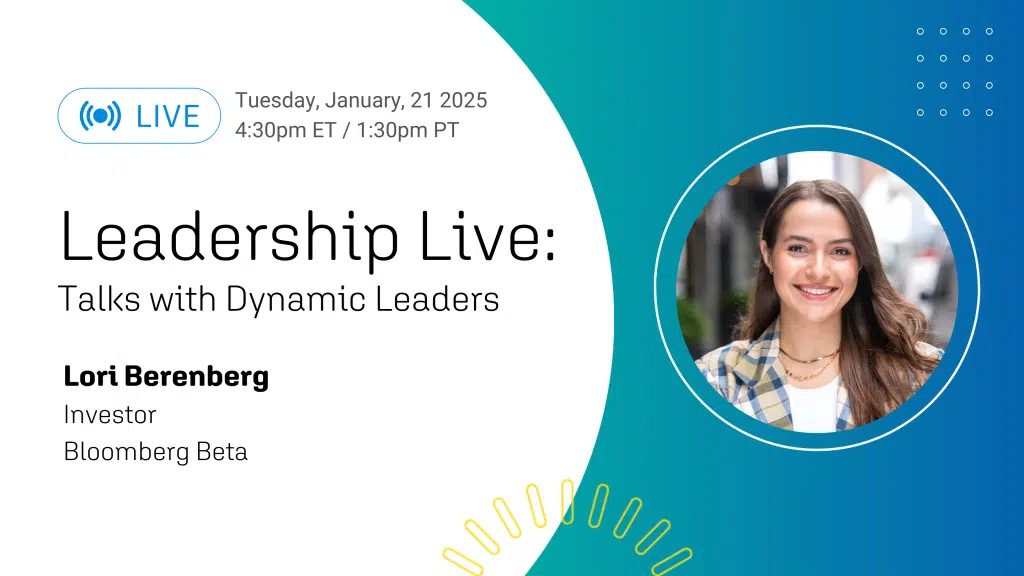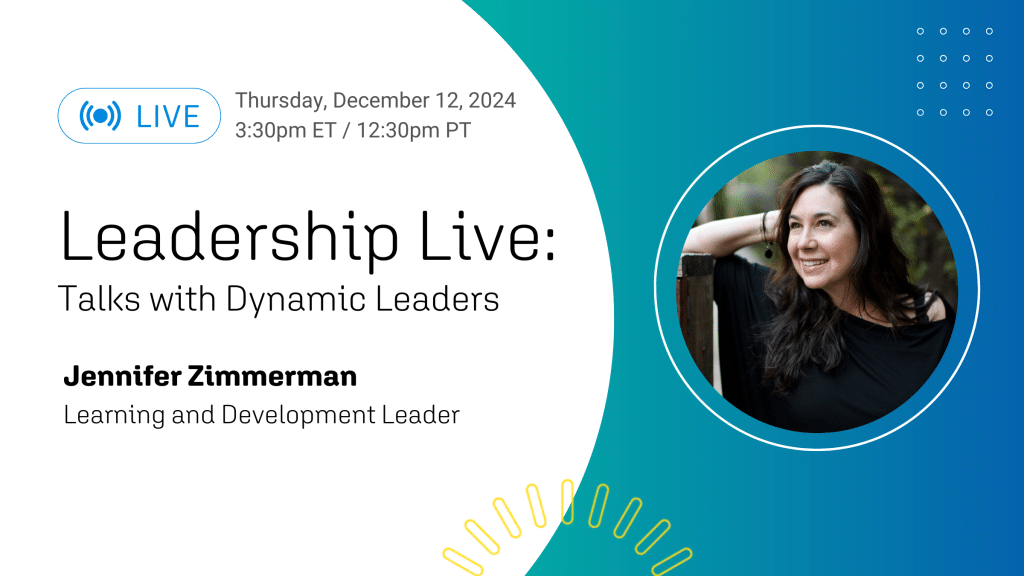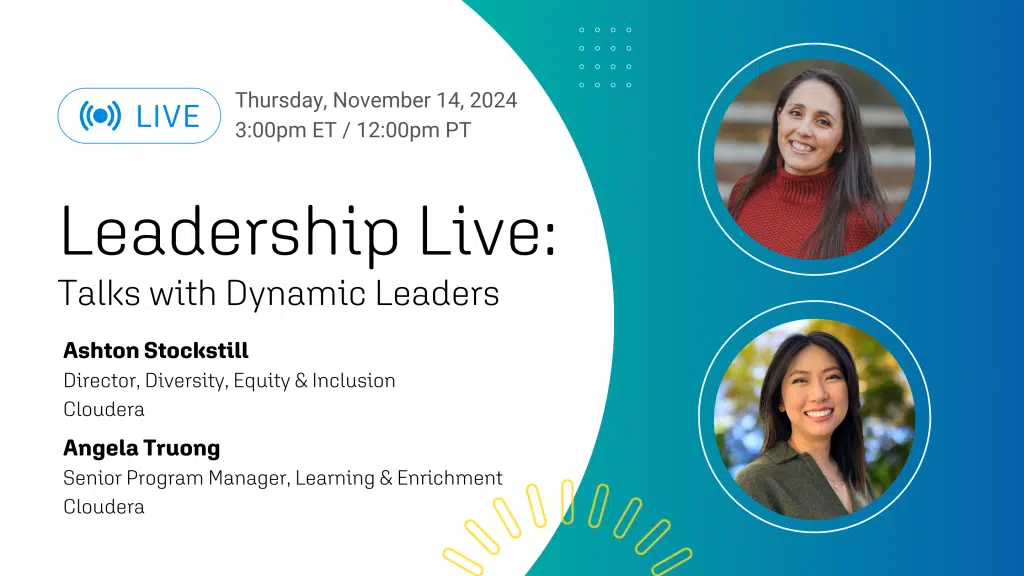Christine sat down with co-founder and author Lori Mazan to discuss what learning and development leaders face as they head into the new year.
Digital transformations continue to be a hot topic for both people leaders and L&D departments. With emerging technology like genAI, many companies are scrambling to adopt and integrate these tools into their workflow, but many of these initiatives will fail.
Lori helps us uncover the hidden truth behind why so many digital transformations fail and what companies can do to beat the curve.
*Transcript has been edited for clarity.
Christine: 85 to 90% of new enterprise applications are going to incorporate generative AI which translates to trillions of dollars going into these initiatives.
But there’s also some statistics that talk about how the majority of transformations actually fail. They don’t meet their business goals and objectives. And, very relevant to the work that we do around leader development, that more than 70% of leaders and managers don’t feel equipped to even lead through that change.
You’re nodding your head as if this is something you’ve always understood. But tell me why.
Lori: When organizations plan these digital transformations, they plan the digital part of it, they plan the execution, the tactical part of it.
What they don’t plan is the change management part of it.
Those planning strategies very often don’t include anything about leaders or equipping leaders to be able to manage this kind of change.
Think about genAI. The pacing of the change is picking up really rapidly and no one really knows where it’s heading. It’s a big experiment right now and yet we are just making a big assumption that our leaders can lead this kind of dramatic change; that they can lead in an environment that’s picking up quickly but is unknown and unpredictable. And we just hope, or wish, or assume that’s gonna happen.
To solve that, plans for digital transformations need to have a line item for leader, development, leader support, change management tools, or team building with dollar numbers next to it. A way to provide both the capacities, the support and the development needs to lead these kinds of huge transformation.
Christine: Well, you’ve already started to allude to some of the things that L&D leaders should be thinking about and addressing as they prep their organizations, but before we dive deeper into what some of those things should be, I do want to touch on the fact that you’ve been a leadership coach for over 25 years and that change is something you’ve seen constantly through that period of time.
Do you feel like there’s anything different about what’s happening now? And how does that impact what L&D leaders and organizations need to do?
Lori: What’s both interesting and potentially disconcerting is the people part of the digital transformations or really any kind of transformations organizations have been trying to have over the last 25-30 years, the biggest point of failure is always the people, right?
That’s the hard part. We can roll out any tool in the world. But if nobody uses it, it doesn’t really make any difference. And then how do you get people to want to use something new and to let go of the old way, to find the value. How do you do that, especially in a case where it could jeopardize their own job? The motivation to do that is not very high.
So you really need exceptional leaders to lead the people towards this transformation, not just the technology.
The pacing is just, you know, growing exponentially. The amount of information available that you have to sort through to try to find what you really need is huge.
Now, I think the unpredictability has increased. You don’t know what’s gonna happen the next day. Like last year, did we know anything about genAI? No, we didn’t. In 2019, did we know there was gonna be a pandemic the next year? No, we didn’t.
So, last century, things were seemingly a little bit more predictable technology, although it grew fast, especially towards the end of the century. It was slower pacing and I think the other key difference is the work force was much more homogenous back then.
Now, the amount of diversity, not only people-diversity, but even job-diversity is growing. Being able to deal with all those differences in the workplace can be really challenging for, for leaders.
There’s a generational factor in there as well. We used to have about three generations in the workforce. Now we have six or seven generations in the workforce and those generations are really different.
Just at Sounding Board, probably a third of the employees are at least 20 years younger than I am.
Christine: Right
Lori: Even you and I, we may be closer in age but there’s often times that we have very different approaches in thinking based on when we entered the workforce.
Christine: Right.
Lori: I think that is additive, right? We put those different points of view together and it creates something interesting and novel and new, but that’s because we’re good at managing that. For others who aren’t as good as managing that, there’s just so much diversity of opinion that it’s hard to link that together and create something innovative out of it.
Christine: As a leader, then what are those important capabilities that they’ll have to build in order for them to be able to meet the challenges of these large transformations?
Lori: Well, Sounding board has a whole set of capabilities and capacities we coach to. But I think in this context where we’re talking transformation, we want to talk about a concept we use called the Big Leap.
We do it in the first session of our coaching engagements that we provide. We look with the participant to find out what is their Big Leap as a leader.
And the reason we talk about the Big Leap is because incremental change is no longer possible. The pacing is too fast for that now.
So we have to have exponential change and that means exponential change in our leaders ability to think in their mindset, in their response, in their behaviors to the current changes.
In the past, you had 20 years to develop yourself as leader. Now you have six months or a year. It has to be exponential. So we talk about this concept of a Big Leap.
We looked through our data at about 60,000 coaching engagements that Sounding Board provided in the last few years. And we came up with the top five Big Leaps as identified by the leaders being coached. These are all named leaders from early managers through the C-suite.
The number one Big Leap was around communication and adaptability. You can see right away how that fits with digital transformation.
The second was developing and utilizing a strategic perspective. It’s no longer good enough to be able to execute on the tactical level. You have to see beyond that and how that is impacting and forwarding the company from a strategic point of view.
The third was empowerment and team dynamics which plays right into how do you get your team adopting new approaches and new tools easily, quickly and feeling empowered around that.
And the fourth related was trust and team management. Over the last few years, the trust has eroded, mostly due to economic situations. Yet, for employees to take on new approaches, there has to be some trust there. So that’s a big issue.
The fifth just has to do with learning and adaptability. All of this transformation requires new learning from everybody and people have to be willing and able to adapt to that new learning.
Christine: Oh, well, that feels like quite a bit and yet it’s big, right?
Lori: It’s actually big.
Christine: And yet there’s a theme and a thread there, I think, which is, as you go through a big change, it’s important that you’re able to adapt and to communicate about that to others. Of course, when you don’t know how to execute against something you’re naturally sort of forced to have to move away from tactics and to have to elevate and think more about a strategic approach that can be applied to a variety of contexts, and a changing situation.
And then I think, you know, the team part is one that we’ve seen a lot as you enact change. How do you empower others to do that? You have to, because you need to be doing that at a rate that it’s much faster and accelerated. So certainly I can’t do it on my own. I’ve got to be able to bring other people along with me, which is that fourth point you made.
And then the last one is certainly we’re all deep in it. We’re all having to learn new skills and technologies, things that we have literally never encountered before.
Lori: Literally for my age group, you know, I, I tell people all the time, like half of my career, we didn’t have email and now we have ja I that we’re trying to use for everything like that leap is, is really big. And younger people are always like, “How did you function without email?” We had ways that worked back then, I guess.
Christine: Yeah, yeah, we used to have these pamphlets, the orange packets to send documents actually from floor to floor.
Lori: And you sign that you read.
Christine: It feels like a long time ago but the reality is it wasn’t right.
You said that this is something that we incorporate into our coaching philosophy at Sounding Board. I do think that’s distinct because oftentimes, if you’re familiar with coaching, you might think that it’s just inquiry based and helping somebody else get to an answer.
But you’re actually saying, no, we’re holding a perspective around, “What’s your Big Leap?” So how does that get incorporated? How does that show up in the coaching, or might be something folks can take away and practice on their own or with their team.
Lori: I think it’s unique because I haven’t heard it in the coaching industry. And the thing about the Big Leap, it’s not actually a small step.
It actually has to be big enough that the leaders react like, “I don’t know if I can do that.” Now, you got the Big Leap. You identify that in the beginning so that everything you do in the next set of sessions leads that leader along the pathway of the leap.
And, you know, you hit some obstacles along the way where the leader might say, “I wasn’t able to do that,” or “I failed,” or “I don’t know if I want to do this anymore.” “This is too hard.”
So you also have to delve in there and find that point of motivation for the leader to be willing to take the interpersonal internal risk and the external risk to take a Big Leap. Because if you’re leaping, you know, you can fall flat on your face too.
The idea is you have a coach there helping you supporting you as you leap, so you don’t fall down.
I saw this video of gymnastics training where they were teaching some young people how to do backflips. They had a belt around their waist and then it had a strap and they were holding the person up so they couldn’t fall down.
I feel like that’s what the coach is for the leader. Leaders try new things, but the coaches, they’re holding them up so they don’t fall down.
They actually learn new ways of thinking and new behaviors and that take them to this Big Leap.
My advice for any leader is to get a coach because this is really hard to do by yourself. For one, it’s really hard to push yourself beyond your self limiting beliefs.
But two, just like those gymnasts, you might not be able to ever do that backflip if you don’t have the help of shaping the body to make that happen by the harness.
The coach does the same thing.
They help shape your thinking so that your chances of success are greatly increased.
Christine: Well, that made me think about the fact that before you do that, there’s moments where you actually can’t see where you’ll land, right? To me, that’s such a great metaphor for these big developments, mindset shifts, behaviors that we have to take as leaders. You actually don’t know what that might change or where that will land. And so it is this leap of faith as well, right?
Lori: It really is a leap of faith. And especially in that case, I used the example of a backflip. So you really can’t see. At least if you’re going forward, you might be able to have an idea where you would land.
But you’re maybe having to go over some deep crevice. So you don’t know if you’re actually gonna make it to the other side. It can be scary and organizations don’t talk about this, but it can be scary for the organization. They’re investing a ton of money and resources and time to try to create this transformation.
And if the stats show that it doesn’t really happen successfully a majority of the time, you know, that’s a big risk that they’re taking.
Christine: You mentioned that the mindset needs to shift in order for these transformations to happen. We’ve spent some time talking about why that mindset shift is open for the leader. What about folks that are delivering these large programs — the L&D leaders that have been told, “Make sure everyone is using genAI. Make sure everyone is more productive. Make sure people are more efficient and effective.”?
What advice would you give them during these times as they think about how to actually build these capabilities in their leaders and support these business transformations?
Lori: I think it’s really tempting for learning and talent leaders to go to the tactical as well and go back to what used to work in the past, the basics. There is basic skill training, because of the digital nature of this transformation. Some basic skilled training is really needed, but that does not generally change mindsets or create long lasting behavior.
So I would really encourage those talent leaders to look beyond skill training.
Even though we talk all the time about upskilling and reskilling, that’s still the basic level of functioning. If you’re talking about leaders, you’re gonna have to go way beyond skilling. You’re gonna have to build capacity; you’re gonna have to build capabilities. Those things have to be contextually driven. Doing online learning that’s generalized for any population might work for how to put a prompt into chatGPT, but that’s not gonna work for how to get your whole team using that successfully on a regular basis.
It’s gonna have to be contextual to your environment, to your culture, to the leadership approach of your company. You’re gonna have to combine these skills, capabilities and capacities because what you have to not only change your own mindset as a leader, you have to change the mindset of those people who are following you. Build up their confidence and their trust and their ability to use all of these things, and maybe even their willingness.
And that’s gonna be very individualized.
Some people are like, “Woohoo, I can’t wait to try this,” and other people are like, “What? I don’t wanna do that. Why would I do that?”
You have a very big range and you have to influence all those people individually.
So some kind of a blanket approach to development doesn’t really work these days. It has to be differentiated, individualized so that you’re changing, not just behavior but mindset. To really stick, has to be contextual. It’s not so easy as just turning on some online learning or teaching someone how to prompt. That’s not nearly enough. It’s not enough for transformation.
We’re talking transformation. It’s not enough for transformation.
Christine:
I think the last point it’s all happening faster. So that means you have to get to the underlying motivation for somebody to shift their behavior. That might be different for you, and what motivates me versus what motivates somebody else on our team.
Lori:
And just for everybody to remember, it’s not motivational to say, “AI is gonna take over your job,” and then try to get someone to actually use AI, so it can take over their job.
You’re gonna have to have to find some ways to talk about what’s in it for the individual to really learn new approaches and utilize them effectively.
Because, that point of motivation — if I know I’m working myself out of a job — I’m clearly not gonna be very motivated to utilize that.
Christine: Yeah, the carrot or stick approach. But it feels like there’s something more than just one of those choices, based on what you’re saying.
Lori: Well, we know from the last 40 years the stick doesn’t really work. So I really encourage people towards the carrot, although maybe it’s the cupcake or something. Not sure the carrot is actually that exciting.
Christine: There is nuance to it. There is actually elements of both fear and of excitement when people are motivated to do things. It’s about how to personalize or individualize that to leaders to get them over the things that cause them fear and move towards the things that get them excited and motivated.
Lori: Yes. It’s actually my opinion that technology plus human ingenuity is what creates that innovation. You really need both parts of that recipe. Just one by itself doesn’t have as large of an impact.
Christine: I feel like this was such an appropriate conversation for January. Many people are making or want to make personal transformations.
But of course, for organizations, although there’s quite a bit of your end planning, now the rubber hits the road. What are those areas you’re really going to invest and sort of run towards to help you be successful this year?
And so I love this idea of the Big Leap.
What is that Big Leap that the organization needs to take and how do we equip not just ourselves, but our organizations to be able to do those successfully?
So any last parting words for folks here as they think about embarking on their own big leaps?
Lori: I’ll just say the last thing. I think you hit on it a little bit. Taking a big leap can be exhilarating. The part we get stuck on first is maybe the scary part or the motivational part.
But once you’re in motion, that motion creates some excitement and some exhilaration and people start to see the potential and what this transformation could mean.
So I would just encourage everyone to start forward on your Big Leap and know that as you start to take your feet off the ground and get up into the air, you’re gonna feel that exhilaration and really be looking out ahead to where you can land.
Big leap starts with a bunch of little steps right before you can get that momentum to make the big jump.








